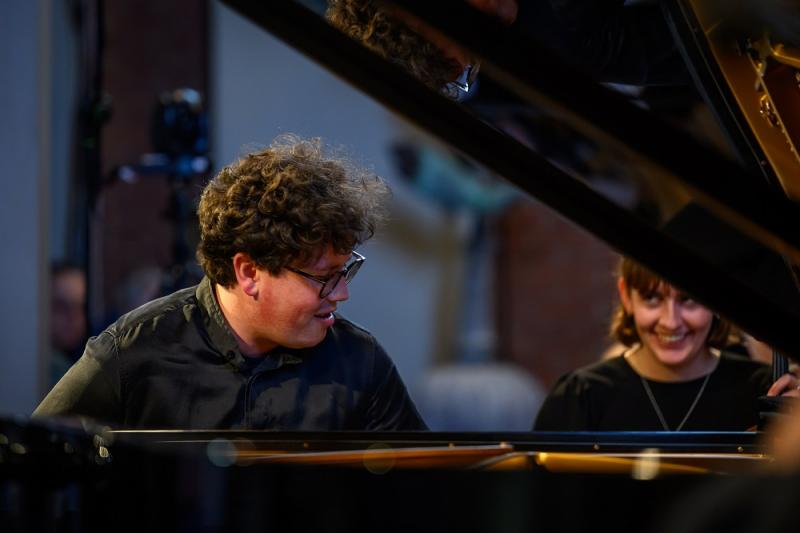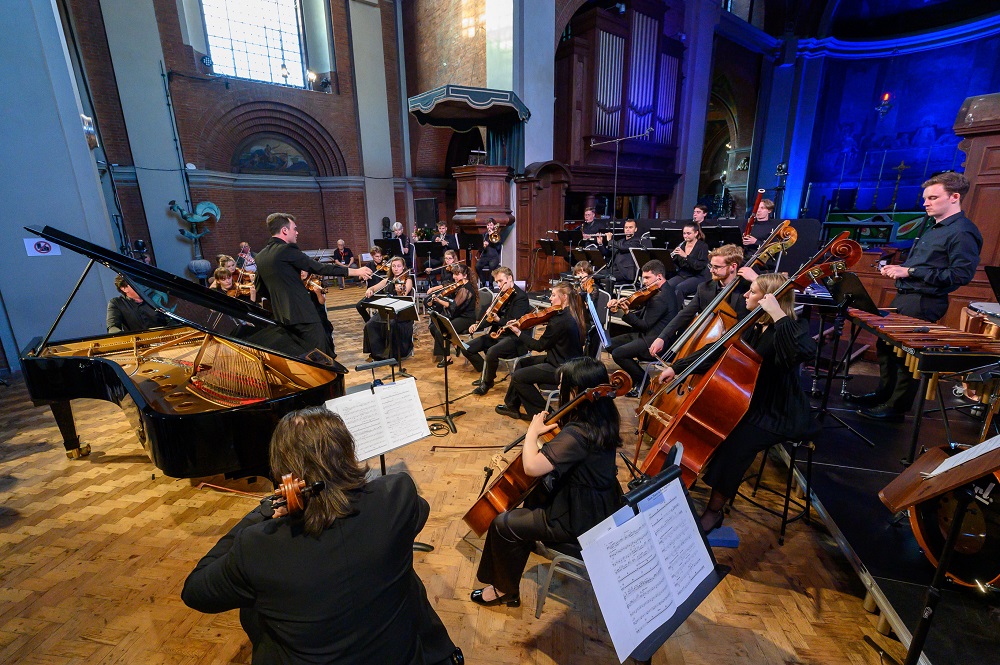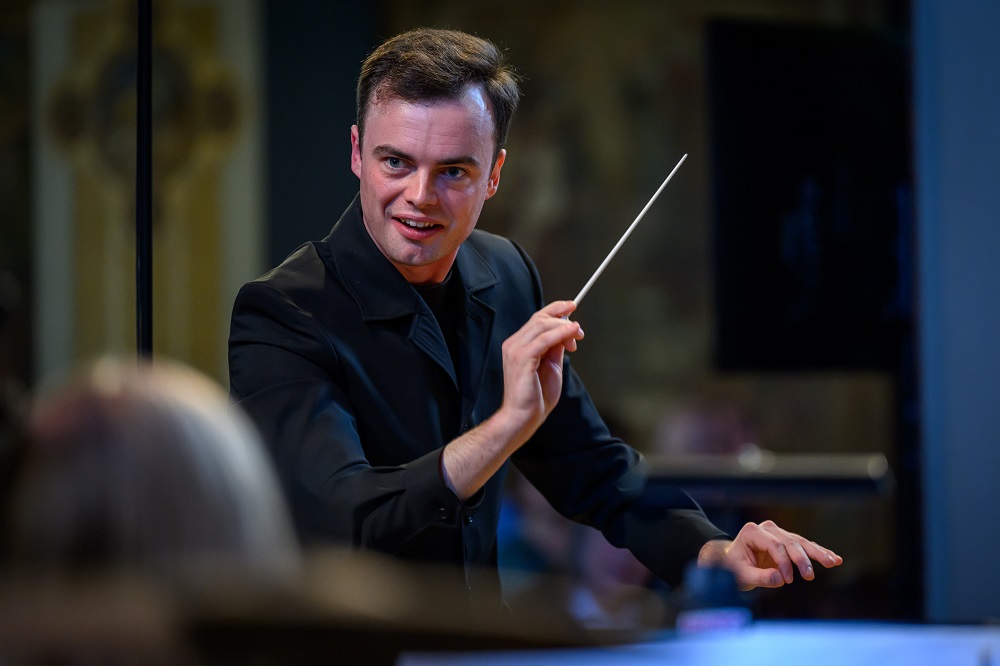Bartlett, Fantasia Orchestra, Fetherstonhaugh, Proms at St Jude's review - Americana both fun and fierce | reviews, news & interviews
Bartlett, Fantasia Orchestra, Fetherstonhaugh, Proms at St Jude's review - Americana both fun and fierce
Bartlett, Fantasia Orchestra, Fetherstonhaugh, Proms at St Jude's review - Americana both fun and fierce
Fascinating, far from easy parade brililiantly executed by top young team

Any programme featuring Gershwin’s top large-scale works might tend to the “pops” side. Bernstein’s West Side Story Overture and even the sweet dream of Florence Price’s Adoration fit that bill. But An American in Paris sounded completely different from usual, its radical side highlighted, following Ives’s Three Places in New England and Ruth Crawford Seeger’s Andante for Strings.
Enterprising Tom Fetherstonhaugh and the (equally) young professionals of his Fantasia Orchestra have been regular visitors to Proms at St Jude's Music & Literary Festival – to give the full, unwieldy name of this venture with its epicentre in Hampstead Garden Suburb – and they share the festival's values of musical opportunities for even younger players, highlighted in the Schools' Prom on 27 June (they also support excellent causes like the North London Hospice). This concert began with a fanfare by 11-year-old Isabella Paulmichi, joint winner with Leo Sellis of the annual Fantastic Fanfare competition.  Then we were off on the roller-coaster ride of the ensemble where Bernstein first placed "Tonight" in West Side Story before deciding that it should also be the main love duet earlier in the drama. St Jude's may be inartistically frescoed and not the loveliest setting, but it's also not too reverberant, or maybe Fetherstonhaugh worked especially hard on focus; strings soared and glowed like a top orchestral section, brass packed the right punch (and the shouted "Mambo"s were loud and clear). Price's now-ubiquitous miniature served as a pretty interlude between romps.
Then we were off on the roller-coaster ride of the ensemble where Bernstein first placed "Tonight" in West Side Story before deciding that it should also be the main love duet earlier in the drama. St Jude's may be inartistically frescoed and not the loveliest setting, but it's also not too reverberant, or maybe Fetherstonhaugh worked especially hard on focus; strings soared and glowed like a top orchestral section, brass packed the right punch (and the shouted "Mambo"s were loud and clear). Price's now-ubiquitous miniature served as a pretty interlude between romps.
I've heard live wire Martin James Bartlett play Rhapsody in Blue three times now, and on each occasion he's seemed to be improvising and totally in the moment. Gershwin would love him. From big concerto roar to Lisztian transcendental delicacy, strutting ragtime to luscious romantics, he ran the gamut. The big screens placed around the church allowed us to read his expressive face at every turn, too. I guessed that he'd play a Gershwin transcription as encore – Earl Wild mixed with a touch of Bartlett – but he wrong-footed me, and how: we were thrown in to a South American blaze with the fearsome third of Ginastera's Danzas Argentinas. To get something of the spirit, watch this performance on YouTube.
The Fantasia players kept tabs on Bartlett's rhapsodizing unerringly, but the real places to show their class – and Fetherstonhaugh's meticulous preparation – were those selected by Ives in his uncanny/crazy triptych. The treacherous time-switches and the difficulty of keeping apparent chaos in focus posed no problems in the central knees-up of "Puttnam's Camp, Redding, Connecticut", while the uneasy idylls of the outer movements held their spell in a space that served them especially well.
It was another bold stroke of Fetherstonhaugh to mirror the simple Price in the middle of the first half with complex Ruth Crawford Seeger, the Andante derived from her String Quartet, in the second. "Heterophony of dynamics," as the composer put it, polytonality, staggered entries and a "melodic line" not so easy to discern make for a lot to absorb in a very little space, but the performance was a beauty.  As Fetherstonhaugh's pleasant spoken introduction to the concert made us aware, so much range from very different composers covers a mere half-century, and An American in Paris was composed a year before Ives made his final revisions to Three Places in New England, three before Seeger's Andante. Iain Farrington's slight downscaling kept the car horns, had to substitute a double-bass for one of the best tuba solos in music, albeit a short one; yet the lurid, even modernistic, melee still worked, and trumpeter William Thomas handled the raucous Charleston as well as the famous blues tune with the right individuality (ditto clarinettist James Gilbert kicking off the Rhapsody in Blue). More of the fine young players were spotlit in an irresistible second half encore, Billy Strayhorn's Take the "A" Train for Duke Ellington and his orchestra, again ingeniously arranged by Farrington. Everyone left happy.
As Fetherstonhaugh's pleasant spoken introduction to the concert made us aware, so much range from very different composers covers a mere half-century, and An American in Paris was composed a year before Ives made his final revisions to Three Places in New England, three before Seeger's Andante. Iain Farrington's slight downscaling kept the car horns, had to substitute a double-bass for one of the best tuba solos in music, albeit a short one; yet the lurid, even modernistic, melee still worked, and trumpeter William Thomas handled the raucous Charleston as well as the famous blues tune with the right individuality (ditto clarinettist James Gilbert kicking off the Rhapsody in Blue). More of the fine young players were spotlit in an irresistible second half encore, Billy Strayhorn's Take the "A" Train for Duke Ellington and his orchestra, again ingeniously arranged by Farrington. Everyone left happy.
- Proms at St Jude's continues until 30 June
- The Fantasia Orchestra plays two Proms with Braimah and Sheku Kanneh-Mason and Plinio Fernandes at the BBC Proms – Prom 20 and the relaxed version, Prom 22
- More classical reviews on theartsdesk
rating
Explore topics
Share this article
The future of Arts Journalism
You can stop theartsdesk.com closing!
We urgently need financing to survive. Our fundraising drive has thus far raised £49,000 but we need to reach £100,000 or we will be forced to close. Please contribute here: https://gofund.me/c3f6033d
And if you can forward this information to anyone who might assist, we’d be grateful.

Subscribe to theartsdesk.com
Thank you for continuing to read our work on theartsdesk.com. For unlimited access to every article in its entirety, including our archive of more than 15,000 pieces, we're asking for £5 per month or £40 per year. We feel it's a very good deal, and hope you do too.
To take a subscription now simply click here.
And if you're looking for that extra gift for a friend or family member, why not treat them to a theartsdesk.com gift subscription?
more Classical music
 BBC Proms: Jansen, Royal Concertgebouw Orchestra, Mäkelä review - confirming a phenomenon
Second Prom of a great orchestra and chief conductor in waiting never puts a foot wrong
BBC Proms: Jansen, Royal Concertgebouw Orchestra, Mäkelä review - confirming a phenomenon
Second Prom of a great orchestra and chief conductor in waiting never puts a foot wrong
 BBC Proms: Royal Concertgebouw Orchestra, Mäkelä review - defiantly introverted Mahler 5 gives food for thought
Chief Conductor in Waiting has supple, nuanced chemistry with a great orchestra
BBC Proms: Royal Concertgebouw Orchestra, Mäkelä review - defiantly introverted Mahler 5 gives food for thought
Chief Conductor in Waiting has supple, nuanced chemistry with a great orchestra
 Dunedin Consort, Butt / D’Angelo, Muñoz, Edinburgh International Festival 2025 review - tedious Handel, directionless song recital
Ho-hum 'comic' cantata, and a song recital needing more than a beautiful voice
Dunedin Consort, Butt / D’Angelo, Muñoz, Edinburgh International Festival 2025 review - tedious Handel, directionless song recital
Ho-hum 'comic' cantata, and a song recital needing more than a beautiful voice
 Classical CDs: Dungeons, microtones and psychic distress
This year's big anniversary celebrated with a pair of boxes, plus clarinets, pianos and sacred music
Classical CDs: Dungeons, microtones and psychic distress
This year's big anniversary celebrated with a pair of boxes, plus clarinets, pianos and sacred music
 BBC Proms: Liu, Philharmonia, Rouvali review - fine-tuned Tchaikovsky epic
Sounds perfectly finessed in a colourful cornucopia
BBC Proms: Liu, Philharmonia, Rouvali review - fine-tuned Tchaikovsky epic
Sounds perfectly finessed in a colourful cornucopia
 BBC Proms: Suor Angelica, LSO, Pappano review - earthly passion, heavenly grief
A Sister to remember blesses Puccini's convent tragedy
BBC Proms: Suor Angelica, LSO, Pappano review - earthly passion, heavenly grief
A Sister to remember blesses Puccini's convent tragedy
 BBC Proms: A Mass of Life, BBCSO, Elder review - a subtle guide to Delius's Nietzschean masterpiece
Mark Elder held back from blasting the audience with a wall of sound
BBC Proms: A Mass of Life, BBCSO, Elder review - a subtle guide to Delius's Nietzschean masterpiece
Mark Elder held back from blasting the audience with a wall of sound
 BBC Proms: Le Concert Spirituel, Niquet review - super-sized polyphonic rarities
Monumental works don't quite make for monumental sounds in the Royal Albert Hall
BBC Proms: Le Concert Spirituel, Niquet review - super-sized polyphonic rarities
Monumental works don't quite make for monumental sounds in the Royal Albert Hall
 Frang, Romaniw, Liverman, LSO, Pappano, Edinburgh International Festival 2025 review - sunlight, salt spray, Sea Symphony
Full force of the midday sea in the Usher Hall, thanks to the best captain at the helm
Frang, Romaniw, Liverman, LSO, Pappano, Edinburgh International Festival 2025 review - sunlight, salt spray, Sea Symphony
Full force of the midday sea in the Usher Hall, thanks to the best captain at the helm
 Elschenbroich, Grynyuk / Fibonacci Quartet, Edinburgh International Festival 2025 review - mahogany Brahms and explosive Janáček
String partnerships demonstrate brilliant listening as well as first rate playing
Elschenbroich, Grynyuk / Fibonacci Quartet, Edinburgh International Festival 2025 review - mahogany Brahms and explosive Janáček
String partnerships demonstrate brilliant listening as well as first rate playing
 BBC Proms: Akhmetshina, LPO, Gardner review - liquid luxuries
First-class service on an ocean-going programme
BBC Proms: Akhmetshina, LPO, Gardner review - liquid luxuries
First-class service on an ocean-going programme

Add comment